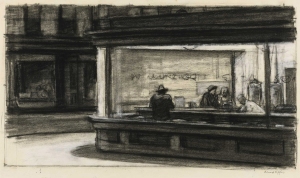 Whitney Museum of American Art, February 2014. Photograph ©Nic Lehoux
Whitney Museum of American Art, February 2014. Photograph ©Nic Lehoux
New Post Goes Up Every Wednesday
The Whitney and the use of the New Media, Part 1
The new Whitney Museum of American Art is scheduled to open on May 1, 2015 in its new building designed by Renzo Piano.
However, through the use of the New Media, the new Whitney is already open to all. Yes, the building will see VIPs of the Art World, Artists, Fashion, and Museum’s at its May 1st Opening, but its Art is now available to everyone through the Whitney’s creative use of the tools of the New Media. While a lot of thought has gone into the planning and design of the new building for people to see its Art in a new setting, the Museum has given to same, if not more thought to those visiting the Museum virtually.
Explore the Whitney’s Collection Online
The Whitney’s collection contains some of the most significant and exciting work created by artists in the United States during the twentieth and twenty-first centuries. You can see it now, no need to wait for the Opening, get tickets, line up for admission, or be governed by opening and closing hours. The fact that the Whitney has made its collection available before the actual opening of the new building shows that the Museum has put the Art before the building, and has put accessibility to everyone ahead of the VIPs.
This is not a small thing, and demonstrates the Museum’s commitment to making its Art Accessible to everyone.Usually one would say, “I can’t wait to go there,” or, more likely, “I wish I could go there,” when it may impossible for you to do so.
By putting the Art first, the Whitney has done a great service to removing the barriers of privilege and wealth to access to Art. As the Museum says,
“The Whitney’s collection online provides unprecedented access to over 21,000 works by more than 3,000 artists. These works in all mediums—painting, sculpture, drawing, printmaking, photography, film, video, installation, and new media—serve as a remarkable resource for understanding art history and the creative process of artists in the United States from 1900 to today. You are invited to explore the breadth and depth of a collection that has helped define what is innovative and influential in American art since the beginning of the twentieth century.”
Edward Hopper
Since there is so much art to see, we will use Edward Hopper as an example of the breadth and depth of the Whitney’s commitment to its mission of making Art accessible to everyone. You can view some 3154 works by Edward Hopper, including the most iconic, and listen the Audio Tour, if you wish.

Edward Hopper
EARLY SUNDAY MORNING
1930
You may also view other Hopper Exhibitions held at the Museum, including one in May 2103 of ” Hopper Drawings,”

Edward Hopper (1882–1967), Study for Nighthawks, 1941 or 1942. Fabricated chalk and charcoal on paper; 11 1/8 × 15 in. (28.3 × 38.1 cm). Whitney Museum of American Art, New York; purchase and gift of Josephine N. Hopper by exchange 2011.65
And his studies for paintings.
As the Museum says,
“Edward Hopper was an incredibly gifted draftsman, though he never intended his studies to be seen as works of art—he used them to try out ideas and refine content for paintings. Featured here are suites of drawn studies in the Whitney’s collection for some of Hopper’s most famous oils. The drawings show two distinct ways of working: in his words, drawing “from the fact” (painting from direct observation), and “improvising” (working from imagination). Taken together, the drawings and paintings reveal how Hopper synthesized precisely observed details or views into atmospheric scenes, transforming the mundane into the poetic.”
You can also watch a video of Hopper’s Studio and a Walking Tour of Hopper’s New York, including the sites of “Early Sunday Morning,” and “The Nighthawks.”
To Be Continued
This is Part 1 of a Series on the Whitney’s use of the New Media to make its Art Accessible to everyone. There is much more to come.